
Kogarkoite is a sodium sulfate fluoride mineral with formula Na3(SO4)F. It has a pale blue color, a specific gravity of about 2.67 and a hardness of 3.5. The crystal is monoclinic and is a type of naturally occurring antiperovskite. Kogarkoite is named after the Russian petrologist Lia Nikolaevna Kogarko (born 1936) who discovered the mineral.
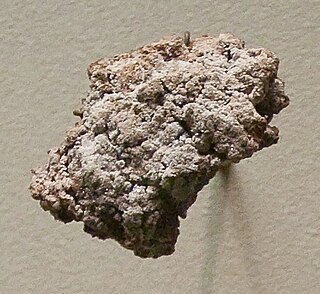
Cotunnite is the natural mineral form of lead(II) chloride with formula PbCl2.

Afghanite, (Na,K)22Ca10[Si24Al24O96](SO4)6Cl6, is a hydrous sodium, calcium, potassium, sulfate, chloride, carbonate alumino-silicate mineral. Afghanite is a feldspathoid of the cancrinite group and typically occurs with sodalite group minerals. It forms blue to colorless, typically massive crystals in the trigonal crystal system. The lowering of the symmetry from typical (for cancrinite group) hexagonal one is due to ordering of Si and Al. It has a Mohs hardness of 5.5 to 6 and a specific gravity of 2.55 to 2.65. It has refractive index values of nω=1.523 and nε=1.529. It has one direction of perfect cleavage and exhibits conchoidal fracture. It fluoresces a bright orange.

Zabuyelite is the natural mineral form of lithium carbonate, with a formula Li2CO3. It was discovered in 1987 at Lake Zabuye, Tibet, after which it is named. It forms colorless vitreous monoclinic crystals.
Ziesite is a copper vanadate mineral with formula: β-Cu2V2O7. It was discovered in 1980 as monoclinic crystals occurring as volcanic sublimates around fumaroles in the crater of the Izalco Volcano, El Salvador. It is named after Emanuel George Zies (1883–1981), an American geochemist who studied Izalco in the 1930s.

Rheniite is a very rare rhenium sulfide mineral with the chemical formula. It forms metallic, silver grey platey crystals in the triclinic - pinacoidal class. It has a specific gravity of 7.5.
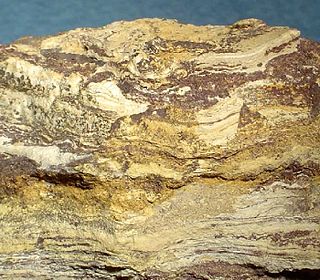
Corderoite is an extremely rare mercury sulfide chloride mineral with formula Hg3S2Cl2. It crystallizes in the isometric crystal system. It is soft, 1.5 to 2 on the Mohs scale, and varies in color from light gray to black and rarely pink or yellow.
Lyonsite (Cu3Fe+34(VO4)6) is a rare black vanadate mineral that is opaque with a metallic lustre. It crystallizes in the orthorhombic crystal system. Lyonsite often occurs as small tabular typically well formed crystals. Lyonsite has a good cleavage and a dark gray streak.

Cadwaladerite is a rare aluminium halide mineral with formula: AlCl(OH)2·4(H2O). It was reported for an amorphous substance associated with sulfate minerals and embedded in a halite crystal cluster. Its status is uncertain due to inadequate data. It was first described in 1941 for an occurrence in mine dumps of the Victoria Segunda mine Cerros Pintados, Iquique province, Tarapacá Region, Chile. It was named for Charles Meigs Biddle Cadwalader, president of the Academy of Natural Sciences. Lesukite was discredited (IMA2018-H).
Altisite (IMA symbol: Ati) is an exceedingly rare alkaline titanium aluminosilicate chloride mineral with formula Na3K6Ti2Al2Si8O26Cl3, from alkaline pegmatites. It is named after its composition (ALuminium, TItanium, and SIlicon).
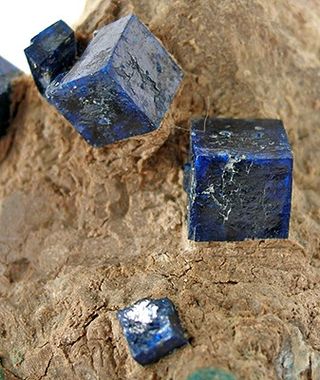
Boleite is a complex halide mineral with formula: KPb26Ag9Cu24(OH)48Cl62. It was first described in 1891 as an oxychloride mineral. It is an isometric mineral which forms in deep-blue cubes. There are numerous minerals related to boleite, such as pseudoboleite, cumengite, and diaboleite, and these all have the same complex crystal structure. They all contain bright-blue cubic forms and are formed in altered zones of lead and copper deposits, produced during the reaction of chloride bearing solutions with primary sulfide minerals.
Sacrofanite is a rare silicate mineral that has the general formula of (Na,Ca)9(Si,Al)12O24(SO4,CO3,OH,Cl)4·n(H2O). It was approved as a mineral by the International Mineralogical Association in 1980. Its name comes from the Sacrofano Caldera in the Monti Sabatini from which it was discovered in Latium, Italy.
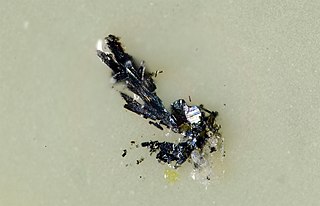
Abramovite is a very rare mineral from the sulfides and sulfosalt categories. It has the chemical formula Pb2SnInBiS7. It occurs as tiny elongated lamellar-shaped crystals, up 1 mm × 0.2 mm in size, and is characterized by its non-commensurate structure.
Krotite is a natural mineral composed of calcium, aluminium and oxygen, with the molecular formula CaAl2O4. It is the low-pressure dimorph of CaAl2O4, of which the high-pressure dimorph is named dmitryivanovite.

Chloroxiphite is a rare olive green to pistacio green lead copper halide mineral with formula: Pb3CuO2Cl2(OH)2.
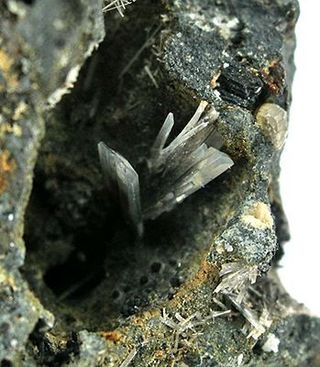
Laurionite is a lead halide mineral. It forms colorless to white crystals in the orthorhombic crystal system and is dimorphous with paralaurionite, both members of the matlockite group.

Ardaite is a very rare sulfosalt mineral with chemical formula Pb19Sb13S35Cl7 in the monoclinic crystal system, named after the Arda River, which passes through the type locality. It was discovered in 1978 and approved by the International Mineralogical Association in 1980. It was the second well-defined natural chlorosulfosalt, after dadsonite.
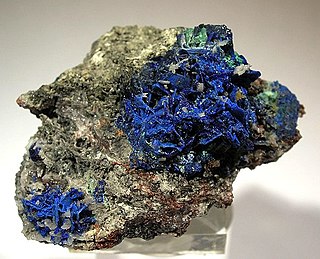
Diaboleite is a blue-colored mineral with formula Pb2CuCl2(OH)4. It was discovered in England in 1923 and named diaboleite, from the Greek word διά and boleite, meaning "distinct from boleite". The mineral has since been found in a number of countries.
Fingerite is a copper vanadate mineral with formula: β-Cu2V2O5. It was discovered as triclinic crystals occurring as volcanic sublimates around fumaroles in the crater of the Izalco Volcano, El Salvador.
Chrysothallite is a rare thallium-bearing chloride mineral with the formula K6Cu6Tl3+Cl17(OH)4•H2O. Chrysothallite is unique in being only the second mineral with essential trivalent thallium, a feature shared with natural thallium(III) oxide, avicennite. Another examples of natural thallium chlorides are steropesite, Tl3BiCl6, and lafossaite, TlCl. Chrysothallite is one of numerous fumarolic minerals discovered among fumarolic sites of the Tolbachik volcano, Kamchatka, Russia The mineral is named in allusion to its colour and thallium content.













